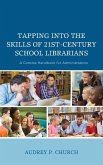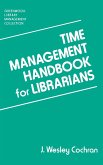- Broschiertes Buch
- Merkliste
- Auf die Merkliste
- Bewerten Bewerten
- Teilen
- Produkt teilen
- Produkterinnerung
- Produkterinnerung
Some students are more "challenging" than most. This book helps school librarians prevent, deal with, and overcome discipline problems they may face when communicating with K-12 students.
Andere Kunden interessierten sich auch für
![Tapping into the Skills of 21st-Century School Librarians Tapping into the Skills of 21st-Century School Librarians]() Audrey P. ChurchTapping into the Skills of 21st-Century School Librarians73,99 €
Audrey P. ChurchTapping into the Skills of 21st-Century School Librarians73,99 €![Soft Skills for Librarians Soft Skills for Librarians]() Dr. Supriya Abhijit BejalwarSoft Skills for Librarians56,99 €
Dr. Supriya Abhijit BejalwarSoft Skills for Librarians56,99 €![Time Management Handbook for Librarians Time Management Handbook for Librarians]() J Wesley CochranTime Management Handbook for Librarians75,99 €
J Wesley CochranTime Management Handbook for Librarians75,99 €![Handbook for Community College Librarians Handbook for Community College Librarians]() Michael A. CrumptonHandbook for Community College Librarians51,99 €
Michael A. CrumptonHandbook for Community College Librarians51,99 €![The Girl-Positive Library The Girl-Positive Library]() Mary Ann HarlanThe Girl-Positive Library47,99 €
Mary Ann HarlanThe Girl-Positive Library47,99 €![Librarians and Educators Collaborating for Success Librarians and Educators Collaborating for Success]() Librarians and Educators Collaborating for Success65,99 €
Librarians and Educators Collaborating for Success65,99 €![Integrating African American Literature in the Library and Classroom Integrating African American Literature in the Library and Classroom]() Dorothy GuthrieIntegrating African American Literature in the Library and Classroom43,99 €
Dorothy GuthrieIntegrating African American Literature in the Library and Classroom43,99 €-
-
-
Some students are more "challenging" than most. This book helps school librarians prevent, deal with, and overcome discipline problems they may face when communicating with K-12 students.
Produktdetails
- Produktdetails
- Verlag: Libraries Unlimited
- Seitenzahl: 116
- Erscheinungstermin: 30. Januar 2012
- Englisch
- Abmessung: 234mm x 156mm x 7mm
- Gewicht: 190g
- ISBN-13: 9781598849868
- ISBN-10: 1598849867
- Artikelnr.: 35071976
- Herstellerkennzeichnung
- Libri GmbH
- Europaallee 1
- 36244 Bad Hersfeld
- gpsr@libri.de
- Verlag: Libraries Unlimited
- Seitenzahl: 116
- Erscheinungstermin: 30. Januar 2012
- Englisch
- Abmessung: 234mm x 156mm x 7mm
- Gewicht: 190g
- ISBN-13: 9781598849868
- ISBN-10: 1598849867
- Artikelnr.: 35071976
- Herstellerkennzeichnung
- Libri GmbH
- Europaallee 1
- 36244 Bad Hersfeld
- gpsr@libri.de
Kay Bishop, PhD, was associate professor at University at Buffalo, The State University of New York.
CONTENTS
List of Figures
Acknowledgments
Introduction
Chapter 1: Positive School Librarian-Student Relationships
Preventing Discipline Problems
Correcting Student Behavior
Following Up Discipline
Chapter 2: Lower Elementary Students
Scheduling
Gaining and Keeping Attention
Rules and Procedures
Storytimes
Table Activities
Transitions
Dealing with Problem Children
Rewards
Working with Teachers, Support Staff, and Parents
Summary
Scenarios
Chapter 3: Upper Elementary Students
Scheduling
Gaining and Keeping Attention
Rules and Procedures
Table Activities
Transitions
Dealing with Problem Children
Rewards
Working with Teachers, Support Staff, and Parents
Summary
Scenarios
Chapter 4: Middle School Students
Scheduling
Effective Communication
Rules and Procedures
Bullying
Class Activities
Dealing with Problem Students
Student Volunteers
Working with Teachers and Support Staff
Summary
Scenarios
Chapter 5: High School Students
Scheduling
Effective Communication
Rules and Procedures
Bullying
Class Activities
Dealing with Problem Students
Working with Teachers and Support Staff
Summary
Scenarios
Chapter 6: Students from Diverse Backgrounds
Effective Communication
Rules and Procedures
Bullying
Class Activities
Dealing with Problem Students
Working with Teachers and Support Staff
Summary
Scenarios
Chapter 7: Technology
Scheduling
Effective Communication
Rules and Procedures
Class Activities
Working with Teachers and Support Staff
Summary
Scenarios
Chapter 8: Library Design and Environment
Overall Environment
Facility Design and Layout
Summary
Scenarios
Works Cited
Index
List of Figures
Acknowledgments
Introduction
Chapter 1: Positive School Librarian-Student Relationships
Preventing Discipline Problems
Correcting Student Behavior
Following Up Discipline
Chapter 2: Lower Elementary Students
Scheduling
Gaining and Keeping Attention
Rules and Procedures
Storytimes
Table Activities
Transitions
Dealing with Problem Children
Rewards
Working with Teachers, Support Staff, and Parents
Summary
Scenarios
Chapter 3: Upper Elementary Students
Scheduling
Gaining and Keeping Attention
Rules and Procedures
Table Activities
Transitions
Dealing with Problem Children
Rewards
Working with Teachers, Support Staff, and Parents
Summary
Scenarios
Chapter 4: Middle School Students
Scheduling
Effective Communication
Rules and Procedures
Bullying
Class Activities
Dealing with Problem Students
Student Volunteers
Working with Teachers and Support Staff
Summary
Scenarios
Chapter 5: High School Students
Scheduling
Effective Communication
Rules and Procedures
Bullying
Class Activities
Dealing with Problem Students
Working with Teachers and Support Staff
Summary
Scenarios
Chapter 6: Students from Diverse Backgrounds
Effective Communication
Rules and Procedures
Bullying
Class Activities
Dealing with Problem Students
Working with Teachers and Support Staff
Summary
Scenarios
Chapter 7: Technology
Scheduling
Effective Communication
Rules and Procedures
Class Activities
Working with Teachers and Support Staff
Summary
Scenarios
Chapter 8: Library Design and Environment
Overall Environment
Facility Design and Layout
Summary
Scenarios
Works Cited
Index
CONTENTS
List of Figures
Acknowledgments
Introduction
Chapter 1: Positive School Librarian-Student Relationships
Preventing Discipline Problems
Correcting Student Behavior
Following Up Discipline
Chapter 2: Lower Elementary Students
Scheduling
Gaining and Keeping Attention
Rules and Procedures
Storytimes
Table Activities
Transitions
Dealing with Problem Children
Rewards
Working with Teachers, Support Staff, and Parents
Summary
Scenarios
Chapter 3: Upper Elementary Students
Scheduling
Gaining and Keeping Attention
Rules and Procedures
Table Activities
Transitions
Dealing with Problem Children
Rewards
Working with Teachers, Support Staff, and Parents
Summary
Scenarios
Chapter 4: Middle School Students
Scheduling
Effective Communication
Rules and Procedures
Bullying
Class Activities
Dealing with Problem Students
Student Volunteers
Working with Teachers and Support Staff
Summary
Scenarios
Chapter 5: High School Students
Scheduling
Effective Communication
Rules and Procedures
Bullying
Class Activities
Dealing with Problem Students
Working with Teachers and Support Staff
Summary
Scenarios
Chapter 6: Students from Diverse Backgrounds
Effective Communication
Rules and Procedures
Bullying
Class Activities
Dealing with Problem Students
Working with Teachers and Support Staff
Summary
Scenarios
Chapter 7: Technology
Scheduling
Effective Communication
Rules and Procedures
Class Activities
Working with Teachers and Support Staff
Summary
Scenarios
Chapter 8: Library Design and Environment
Overall Environment
Facility Design and Layout
Summary
Scenarios
Works Cited
Index
List of Figures
Acknowledgments
Introduction
Chapter 1: Positive School Librarian-Student Relationships
Preventing Discipline Problems
Correcting Student Behavior
Following Up Discipline
Chapter 2: Lower Elementary Students
Scheduling
Gaining and Keeping Attention
Rules and Procedures
Storytimes
Table Activities
Transitions
Dealing with Problem Children
Rewards
Working with Teachers, Support Staff, and Parents
Summary
Scenarios
Chapter 3: Upper Elementary Students
Scheduling
Gaining and Keeping Attention
Rules and Procedures
Table Activities
Transitions
Dealing with Problem Children
Rewards
Working with Teachers, Support Staff, and Parents
Summary
Scenarios
Chapter 4: Middle School Students
Scheduling
Effective Communication
Rules and Procedures
Bullying
Class Activities
Dealing with Problem Students
Student Volunteers
Working with Teachers and Support Staff
Summary
Scenarios
Chapter 5: High School Students
Scheduling
Effective Communication
Rules and Procedures
Bullying
Class Activities
Dealing with Problem Students
Working with Teachers and Support Staff
Summary
Scenarios
Chapter 6: Students from Diverse Backgrounds
Effective Communication
Rules and Procedures
Bullying
Class Activities
Dealing with Problem Students
Working with Teachers and Support Staff
Summary
Scenarios
Chapter 7: Technology
Scheduling
Effective Communication
Rules and Procedures
Class Activities
Working with Teachers and Support Staff
Summary
Scenarios
Chapter 8: Library Design and Environment
Overall Environment
Facility Design and Layout
Summary
Scenarios
Works Cited
Index








